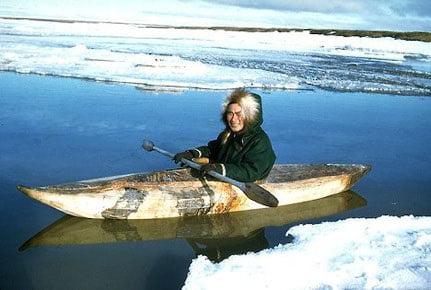It is one of the most stable and maneuverable kayaks on the market. It offers an incredible amount of deck space, high gunnels, a large front storage compartment, an in-deck tackle storage option and plenty of room for H-crates or tackle (coolers, etc.) on the back. The H-rail system allows you to attach almost anything (depth finders, nets, cup holders, GPS, etc.) so you are only limited by your imagination. The Hobie is powered by pedals or paddle and now can turn 360 degrees.
Some are outfitted with Power Poles, Anchor Wizards; you can even attach a Torqueedo to the back of the kayak to allow for shorter times between fishing spots. This is just one of the new models on the market.
So how much more advanced can the kayaks really get and still be legal for tournament fishing?
What is the Definition of a Kayak?

I tried to find a true definition for “kayak” to help me find the limits. It is less defined than I expected, but here is the Merriam-Webster version:
Kayak
: a light narrow boat that has both ends tapered to a point, is propelled by a double-bladed paddle, and often has a closed top except for an opening in which the paddler sits with the legs extended straight out in front:
a : a traditional boat that is typically associated with the indigenous peoples (such as the Aleuts and Inuits) of Alaska, Canada, and Greenland, is usually made of a frame of wood or bone covered with animal skin, and is used especially for hunting and transport
b : a boat that is based on the traditional kayak and is typically made of plastic or fiberglass and is used especially for recreational purposes

If you look at the BASS tournament guidelines for their definition, they get a bit more specific:
B.A.S.S. Kayak Regulation Guidelines
- Watercraft propulsion is restricted to paddle, pedal, pole, or electric motor. (See electric motor restrictions, below.)
- Unless specifically prohibited, use of electric motors in competition is approved with the following restrictions:
- Electric motor must be attached to the kayak in a safe manner for operation.
- An electric motor used to propel a watercraft may not exceed the lesser of (a.) manufacturer’s labeled Maximum HP/Thrust Capacity, (b.) 3 HP, or (c.) 155 foot-pound thrust.
- Competitors must comply with all boating regulations pertaining to motorized kayak/electric-propulsion watercraft registration, use, and operating restrictions for the designated fishing area.
- No more than one electric motor may be attached to a kayak regardless of combined horsepower/thrust/power rating.
- Motors with dual props operated by a single power source are permissible as long as the unit is manufactured and sold as a single unit.
- Vessel must be 9’ minimum and shorter than 18’.
- Vessel that the manufacturer identifies and sells as a kayak, including inflatable kayaks and modular kayaks, Stand-up paddleboards (SUP) and Canoes.
- Other watercraft specifically approved as exceptions in advance of competition by B.A.S.S. Management
- Catamaran style personal fishing vessels complying with all other regulations will be eligible.
- No “Homemade” Kayaks, Sailboats, Jon boats, pirogues, coracles, rowboats, dinghies, skiffs, float tubes, inflatable rafts, or rigid inflatable boats (e.g., Zodiac), pontoon boats, pontoon-style pond boats, twin-hull watercraft, or similar.
KBF and the Hobie BOS definitions are very similar; KBF does not list the length requirement.
What I was surprised to find was the lack of a width requirement. If that door is open, how wide can I make the kayak? With one dimension of flexibility, how much more is possible? And, catamarans are allowed?

Is Isomething like this CraigCat Elite or their Catch It version allowed if marketed as a kayak?
As long as I don’t make it myself, I can have a 5-8 foot wide catamaran to fish in the kayak tournaments as long as I do not exceed three hp or 155 ft pounds of propulsion and it is between 9’ and 18’ in length.
By allowing these style boats, the possibilities are endless.
I can add virtually anything that is on a typical bass boat without a width restriction. I know this may seem like a stretch and some will argue the point, but based upon all rules defined by the large tournament trails, the kayaks can get wider — becoming platforms to stand on.
The reality is that I see this changing the first time someone challenges the no-width rules.
Should the Rules be Changed?
So back to my original question; how much more advanced can the kayaks of today really get? I personally think that for the “kayak” as just that, a kayak… we are already pushing the limits.
There is room for new hull designs, different hull materials, storage options, different motors, fish finders, seats and possibly advancements in propulsion methods, but to call it a kayak and stay within those boundaries defined by tournament rules will make it hard to add tons of… wait…
There is no height limit either.
Maybe more storage under the deck, rod storage…
I have seen technology explode in my lifetime, so I am hesitant to draw a ceiling.
What are your thoughts?
This article was contributed by an ANGLR Expert
Become an ANGLR Expert and apply here.


